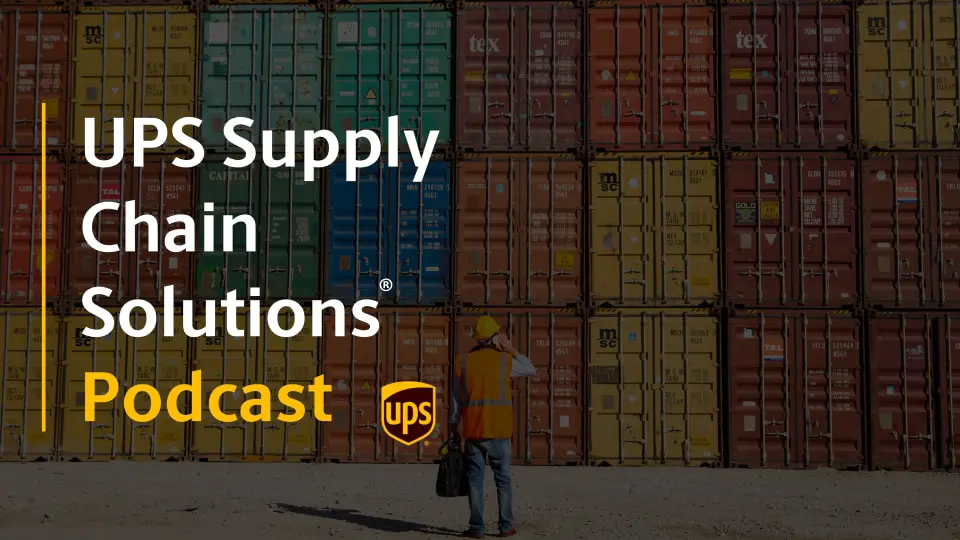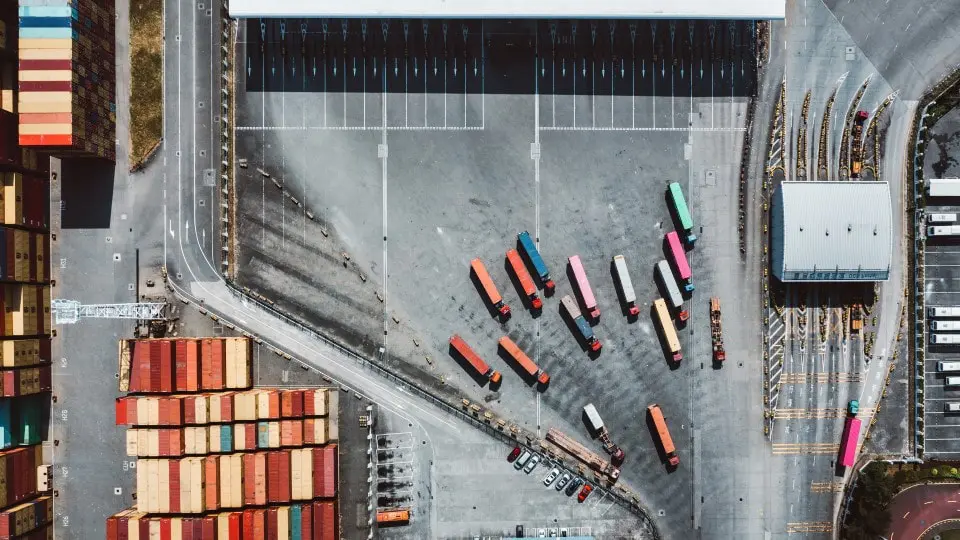1. "Mexico Biggest U.S. Trading Partner in 2023 To-Date." Statista. September 25, 2023. https://www.statista.com/chart/7749/most-important-trading-partners-of-the-united-states/#:~:text=Foreign%20Trade&text=Sep%2025%2C%202023-,Trade%20in%20the%20U.S.,in%20the%20year%20to%2Ddate
This guide contains:
- What Is Nearshoring?
- How Is Nearshoring Different From Offshoring or Reshoring?
- Where Are Companies Moving for Nearshoring?
- Should Your Company Set Up a Nearshoring Solution?
- What Are the Benefits of Nearshoring?
- Things to Consider When Setting Up a Nearshoring Solution
- How to Set Up a Nearshoring Solution At UPS
What Is Nearshoring?
Nearshoring, or sometimes referred to as a ‘Trade Lane Shift,’ is when a company moves a business function from an offshore location closer to their home country. This geographic shift can be made to take advantage of tax benefits, align workers in the same time zone, take advantage of cheaper labor costs and more. Many companies utilize Nearshore outsourcing for their information technology, research & development, warehousing and manufacturing functions.
How Is Nearshoring Different From Offshoring or Reshoring?
Offshoring means to move your business’ operations to another country. This term became popular in the 1970s and 1980s as more and more companies moved their operations overseas to improve efficiencies and reduce their labor costs. For example, moving a manufacturing operation from the United States to China.
Nearshoring is a subset of offshoring, but instead of moving operations to another country, businesses are moving their operations to a country nearby their home country. An example of this is moving the manufacturing operation from China to Mexico, a nearby country of the United States.
Reshoring, also known as onshoring, is when companies choose to bring their operations or services back to the original country of the company. Reasons for reshoring can include rising transportation costs, geopolitical challenges, supply chain constraints or instability, and increased labor costs.

Where Are Companies Moving for Nearshoring?
Nearshoring is just a trade lane shift and therefore can be done anywhere in the world and mostly depends on the company’s home country.
Mexico: For a lot of companies headquartered in the United States, Mexico has become a popular location for a Nearshoring solution. This arises from a few factors:
- The proximity to the United States makes receiving inventory quicker instead of waiting for shipping coming from Asia.
- The duty and tax benefits for companies who were originally manufacturing or sourcing products in China. Since the Section 301 tariffs went into effect in 2018, there has been a big reconsideration for companies shipping from Asia to the United States. By setting up a nearshoring solution in Mexico or a close neighboring country, companies may be able to alleviate the impact of Section 301 tariffs and take advantage of the USMCA free trade agreement between Mexico and the United States.
- Mexico is a prominent trading partner with the United States. In 2023, Mexico was the largest trading partner with the United States.1
China Plus One: Another common trade lane shift that companies located in the United States and globally are taking advantage of is called “China Plus One.” China Plus One is a business strategy meant to diversify a company’s supply chain to avoid growing too reliant on one country’s productions. In these situations, companies will still do most of their business in China but choose to also set up an operation in a nearby, separate country. The two different operations are intended to reduce risk through geographical diversification.
Should Your Company Set Up a Nearshoring Solution?
There are lots of reasons why nearshoring continues to be a strategic initiative for many companies. You might consider developing a nearshoring strategy and solution if you’re dealing with the following scenarios:

Duty and Tax Mitigation
Duties and taxes can have a significant impact on operating margin, and these charges can vary significantly depending on a number of different variables. The specific commodity and Country of Origin are the primary factors, and not all lane pairings are created equally. Sourcing or manufacturing a product in one country may carry very different duty implications versus manufacturing it in another. Additionally, Free Trade Agreements between countries could yield much more favorable duty rates than sourcing from a country without these types of agreements in place. If you haven’t analyzed your duty rates – or you think your current duty rates aren’t optimized – UPS Customs Brokerage can help you consider the duty implications of moving manufacturing or distribution to another country.
Network and Capacity Optimization
When companies are looking to upgrade their facility or expand into a new one, they often default to what they know – expanding their footprint somewhere in their domestic market or from traditional sourcing hotspots in Asia. However, nearshoring could be a more cost-effective and viable alternative. Utilizing a warehouse in a new market, close to your end-customer, could yield more favorable overhead costs (e.g. rent, utilities, labor, etc.), and you might be able to take advantage of preferential duty treatment (especially for products that are under the United States’ $800 deminimus value). With a country as large as the United States, a strategically located warehouse in Mexico may even improve your time-in-transit to your US-based distributors or end customers. If you’re having capacity constraints and/or are looking to increase your physical footprint, then a Nearshoring solution could be a viable option.
Inventory Management
Inaccurate forecasting, unexpected demand, seasonality, transportation-related delays, governmental intervention: there are multiple reasons why a company may find themselves without inventory and in critical need of replenishing it. Nearshoring puts your products closer to where you do business and that reduced proximity improves time-in-transit and mitigates the risk of delays. The ability to flex your network and get product in a timely manner can be the difference-maker on those ever-important annual financial statements.
What Are the Benefits of Nearshoring?
There are a lot of benefits to setting up a Nearshoring solution. Below are the top three benefits your company could experience.
Tax Benefits
There are a couple different ways that Nearshoring could assist with taxes.
- Avoiding Section 301 Tariffs. The Section 301 tariffs were applied in 2018 to products imported into the United States from China totaling $50 billion dollars. The high tariffs are only applied to goods of Chinese origin imported to the United States, causing companies to source materials from other countries. By manufacturing goods in Mexico rather than China, and then shipping to the United States, companies can avoid the high tariffs on their products and take advantage of the free trade agreement between the United States, Mexico and Canada (USMCA).
- Preferential Duty. Preferential Duty is a specific benefit that is granted to companies through the USMCA free trade agreement. If a company decides to source materials from Mexico instead of another country and thus creates more jobs in Mexico, the USMCA agreement may allow for preferential duty on the parts that were sourced or manufactured in Mexico. The same applies for production in Canada and the United States as well.
Faster Shipping Times
The obvious reason why shipping times would be faster is due to the close proximity of the Nearshoring solution compared to the home country. If a United States-based company sets up a Nearshoring solution in Mexico, the transit time to move the products would be only a couple days instead of a couple weeks. This is because of the well-established ground and air network between Mexico and the United States that gives companies more flexibility when choosing their transportation mode.
The less obvious reason as to why shipping times would be faster with a Nearshoring solution is due to labor shortages. When companies diversify their sourcing locations, they reduce the risk of halting their supply chains due to labor shortages, constrained capacity, etc. By having some operations spread out across multiple regions, it reduces the impact to your supply chain because not all cargo is being handled and held at one port.
Environmental, Social & Governance (ESG) Benefits
Nearshoring can help companies prioritize their ESG (Environmental, Social and Governance) initiatives.
- Environmental. A benefit of sourcing materials from neighboring countries is companies are reducing their carbon footprint. By sourcing materials from their local regions, companies aren’t having to ship materials as far, leading to a reduction in their carbon footprint.
- Social. Intellectual Property has been a concern with sourcing from China and is one of the reasons that the Section 301 tariffs were originally established. With sourcing materials in other countries outside of China, it reduces the risk that your intellectual property will be compromised.
- Governance. The United States has placed a large focus on forced labor, specifically coming out of China with the Uyghur Forced Labor Prevention Act. By sourcing materials outside of China, this reduces the chance that products in a company’s supply chain could be made with forced labor. Also due to the stricter labor regulations included in USMCA, companies can have more confidence that their supply chains aren’t promoting forced labor.
Things to Consider When Setting Up a Nearshoring Solution
Making a capital investment towards nearshoring is a lot easier said than done. UPS can help you develop that long-term strategy, but for now, here are some things that you might want to consider before exploring a Nearshoring solution further.

Proprietary Nature of your Product
From a technological and engineering standpoint, there’s a big difference between your coffee mug and your laptop. The coffee mug requires less raw materials and intellectual capital to produce than the laptop. You’ll need to assess the viability of having your particular product manufactured in another country. Products that utilize more common manufacturing processes are more obvious candidates for Nearshoring (e.g. injection molding, casting, machining, etc.). This doesn’t mean that a complex product can’t be manufactured somewhere else. However, it is something that warrants consideration as you explore the possibility of Nearshoring.
Information and Process Management
Another factor to consider is how you manage your fulfillment processes. If a customer in Ohio purchases your product, you could either fulfill that order from your California-based warehouse, or from your new 3PL partner in Mexico. Some things to keep in mind are: what criteria you use in order to determine where to fulfill the order from (e.g. transportation cost, time-in-transit)? How do you make sure the order goes to the right facility? Will your inventory management system reflect the order correctly? These are all rhetorical questions for now; but UPS can help you optimize your network around Nearshoring while considering the various implications of your expanded supply chain.
Regulatory Provisions and Implications
Before setting up a nearshoring solution, it’s important to think about the regulatory implications of the product your company manufactures. Let’s say you’re building lamps and you source the lamp base, made of raw aluminum, from China and import and modify the components into the end-product in Mexico. Since the parts came from a couple different countries, you need to keep track of each part’s Country of Origin and beware of the risk associated with improperly classifying the Country of Origin. It’s helpful if you have an internal team or department that can assess these types of things, but in absence of that, UPS makes a great partner to help you navigate these types of discussions.
How to Set Up a Nearshoring Solution At UPS
Nearshoring is a complex solution that can help your company save millions of dollars. This is no small task, and you need someone trustworthy to set up a solution this large.
Looking for nearshore outsourcing companies? Reach out to one of our experienced Nearshoring professionals to get started and learn more about set up costs and potential savings.
More Nearshoring Resources

Introduction to The Trade Lane Shift
This podcast discusses the factors that led to nearshoring becoming a popular supply chain topic and why this phenomenon has received increased attention in recent years.
Listen to the PodcastOpen the link in a new window
Setting Up a Nearshoring Solution
Listen to Jose Garcia, Vice President of LATAM for UPS Supply Chain Solutions identify what it takes to set up a near-sourcing or near-manufacturing operation.
Listen to the PodcastOpen the link in a new window
Realities of Nearshoring
Listen to learn about the nearshoring trend, its benefits and challenges and what to consider to successfully move your supply chain closer to home.
Watch the WebinarOpen the link in a new windowUPS Supply Chain Solutions Services

Freight Services
Moving freight is an essential part of a nearshoring solution. Find the freight forwarding service that’s right for you.
Explore Freight Services
Warehousing & Distribution
If you are setting up a nearshoring solution for your company, you need a warehousing provider with expertise, facilities infrastructure and supply chain technology to help you achieve your goals.
Explore Warehousing
Supply Chain Technology
Supply chains are constantly changing. You need supply chain technology that scales with your business, and we have it already ready for you.
Explore Our Innovative Solutions
